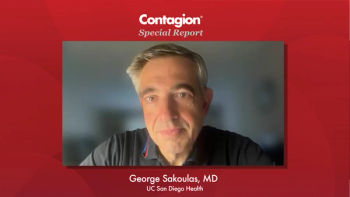
- February 2020
- Volume 5
- Issue 1
Clinical Characteristics of the First 2019-nCoV Cases in Wuhan, China
A new article published in The Lancet features information on epidemiology, laboratory, and radiology elements of the first 41 cases of the novel coronavirus confirmed in Wuhan, China.
Cases of the novel coronavirus (2019-nCoV), which originated in China, have now spread to Japan, Thailand, South Korea, Singapore, and the United States. Over 557 cases of the novel virus have been
On January 24, the US Centers for Disease Control and Prevention
A team of investigators from Wuhan, China, have also released an article detailing the clinical characteristics of the first 41 patients infected with 2019-nCoV. Their article, featuring information on epidemiology, laboratory, and radiology elements of the initial cases confirmed in Wuhan was published in
According to the investigators, characteristics were determined by analyzing data from laboratory-confirmed cases of the virus via real-time polymerase chain reaction and next-generation sequencing. Data were also obtained from forms shared by the International Severe Respiratory and Emerging Infection Consortium from electronic medical records. The team also communicated directly with patients and their families to collect symptom data.
All patients with suspected 2019-nCoV were admitted to a designated hospital in Wuhan. By January 2, 2020, 41 admitted hospital patients had been confirmed to have 2019-nCoV infection.
Symptoms
The article notes that 73% of the infected patients were men and the median age of patients was 49 years (interquartile range [IQR]: 41.0-58.0). Twenty-seven of the 41 patients were exposed to the Huanan seafood market and 1 family cluster of 2019-nCoV infection was observed. In total, 32% of patients had underlying diseases which included diabetes (8), hypertension (6), cardiovascular disease (6).
Common symptoms at the onset of illness included fever (98% of cases), cough (76%), myalgia or fatigue (44%). Less common symptoms that were recorded included sputum production (28%), headache (8%), hemoptysis (5%) and diarrhea (3%).
Dyspnoea developed in 55% of patients (median time for illness onset to dysponea 8.0 days [IQR: 5-13]). In 63% of the patients, lymphopenia was observed. Abnormal findings on chest CTs were observed for all 41 patients.
According to the authors, complications of the infection included acute respiratory distress syndrome (29%), RNAaemia (15%), acute cardiac injury (12%) and secondary infection (10%). Among the 41 patients, 13 were admitted to an intensive care unit (ICU) and 6 patients died.
“Compared with non-ICU patients, ICU patients had higher plasma levels of IL2, IL7, IL10, GSCF, IP10, MCP1, MIP1A, and TNFα,” the investigators wrote. “The 2019-nCoV infection caused clusters of severe respiratory illness similar to severe acute respiratory syndrome coronavirus and was associated with ICU admission and high mortality.”
As of January 22, 28 of 41 patients have been discharged from the hospital. Decision for discharge was based on reduction of fever for at least 10 days, and improvement of chest radiographic evidence, and viral clearance in respiratory samples from the upper respiratory tract.
>>READ:
>>READ:
Treatment
The investigators indicated that among the 41 cases in this cohort, corticosteroids were given to “very few non-ICU cases, and low-to-moderate dose of corticosteroids were given to less than half of severely ill patients with acute respiratory distress syndrome.” The authors wrote that more evidence is needed to determine whether systemic corticosteroid treatment is beneficial or harmful for patients with the novel virus and that no antiviral treatment for coronavirus has proven to be effective.
The authors also reported that in a historical control study among patients with SARS-CoV the combination of lopinavir and ritonavir was associated with substantial clinical benefit and fewer adverse clinical outcomes.
Since 2019-nCoV is an emerging virus, there is currently no effective treatment for disease resulting from this virus. As such, investigators have launched a randomized controlled trial to quickly assess if the combination of lopinavir and ritonavir in patients who have been hospitalized with confirmed 2019-nCoV infection.
“Major gaps in our knowledge of the origin, epidemiology, duration of human transmission, and clinical spectrum of disease need fulfilment by future studies,” the investigators concluded.
Articles in this issue
over 5 years ago
Oseltamivir on the Move, but Where Should It Go?over 5 years ago
Diagnostic Stewardship: Beyond Managing Bloodstream Infectionsover 5 years ago
Never Ignore a New Rash in a Patient With AIDSover 5 years ago
Imipenem-Cilastatin-Relebactam: Imipenem Is Rele Back AgainNewsletter
Stay ahead of emerging infectious disease threats with expert insights and breaking research. Subscribe now to get updates delivered straight to your inbox.































































































































































































































































































